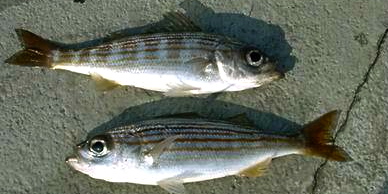Grunts—Family Haemulidae
Salema from the Ocean Beach Pier in San Diego
Species: Xenistius californiensis (Steindachner, 1876); from xenitius (strange sail, in allusion to the dorsal fin) and californiensis (in reference to California as a geographic area).
Alternate Names: Bass, big eye, big eye bass, striped bass and lima perch. In Mexico called salema, pajarillo or ojotón.
Identification: This pretty little fish resembles a striped bass in shape and is even striped, but both color and range is different. Salema have a bass-like body, very large eyes, and 6-8 orange-brown horizontal stripes on the side. Their coloring is iridescent blue-green above, and silvery below; tail fins orange-brown. They will often also make a grunting noise when removed from the water. They are sometimes mistaken for small striped bass.
Size: Up to 12 inches but most caught off piers are only 6-8 inches long.
Range: Found from Peru to Monterey Bay but reportedly most common south of Dana Point. My records however show they are most commonly caught from piers between Oceanside and Santa Monica. They are uncommon north of Point Dume and rare north of Santa Barbara.
Two salema taken from the Hermosa Beach Pier in 2008
 Habitat: Shallow-water rocky areas and in kelp beds. Salema are usually found in schools and though primarily nocturnal feeders they also forage (and bite) during the day. The young often school with juvenile sargo and black croaker.
Habitat: Shallow-water rocky areas and in kelp beds. Salema are usually found in schools and though primarily nocturnal feeders they also forage (and bite) during the day. The young often school with juvenile sargo and black croaker.
Piers: Best bets: Oceanside Pier, San Clemente Pier, Seal Beach Pier, Redondo Beach Pier, Hermosa Beach Pier, and Manhattan Beach Pier. I have also taken quite a few from the Cabrillo Mole in Avalon but only during nighttime hours. In addition, I have seen a number taken from the Port Hueneme Pier and Ventura Pier—both supposedly in areas where salema are considered uncommon.
Shoreline: Rarely taken by shore anglers.
Boats: Rarely taken from boats.
Bait and Tackle: These fish will take most small baits on a size 6 or 8 hook, including small pinhead anchovies. Most, however, are caught on mussels, bloodworms, or a small strip of anchovy or mackerel. Fish around the pilings and fish from just off the bottom to mid-depth.
Food Value: Salema are a mild-flavored fish, best suited for pan-frying.
Comments: Although this is a small fish, its relative scarcity and attractive appearance make it a worthwhile catch (and they give a good, rugged little battle when caught on ultra-light tackle). I’ve always thought they would make a beautiful saltwater aquarium fish.
I’m not sure where the name derives but there is a small fishing village on the coast of Portugal named Salema. Although once considered part of the “last undiscovered tourist frontier,” those days apparently are over (at least according to the esteemed travel expert Rick Steves). It’s been discovered.
In 2006 Practical Fishkeeping Magazine reported: “Men hallucinate after eating fish. Two men have suffered terrifying visual and auditory hallucinations after eating a popular local seafish in Mediterranean restaurants… the men started seeing and hearing things after contracting a rare form of hallucinogenic poisoning from the Salema fish they were dining on… The effects of eating ichthyoallyeinotoxic fishes, such as certain mullet, goatfish, tangs, damsels and rabbitfish, are believed to be similar to LSD, and may include vivid and terrifying auditory and visual hallucinations. This has given rise to the collective common name for ichthyoallyeinotoxic fishes of ‘dream fish’. The poisoning can start to cause vivid hallucinations within minutes of eating a poisonous fish and may last for days, often with no other effects. There is no antidote… Indoles, with similar chemical effects to LSD (lysergic acid diethylamide) are believed to be responsible and may be consumed when the fish eat algae or phytoplankton containing the chemicals. All of the species affected by ichthyoallyeinotoxism are algal grazers. Others have claimed that different species of ichthyoallyeinotoxic fishes, such as Kyphosus fuseus, contain much more potent hallucinogens, such as dimethyltryptamine or DMT, which is considered to be one of the world’s most mind-bending hallucinogenic chemicals… Sarpa salpa, the fish consumed by the men was a member of the Sparidae family and is commonly known as the Salema porgy… According to the paper, Sarpa salpa was consumed as a recreational drug in the Med during the Roman Empire.” So there you have it, the salema in California were not the culprit in this strange episode of hallucinogenic poisoning even though California, especially the Haight-Ashbury District of San Francisco would seem a natural place for such an occurrence.















